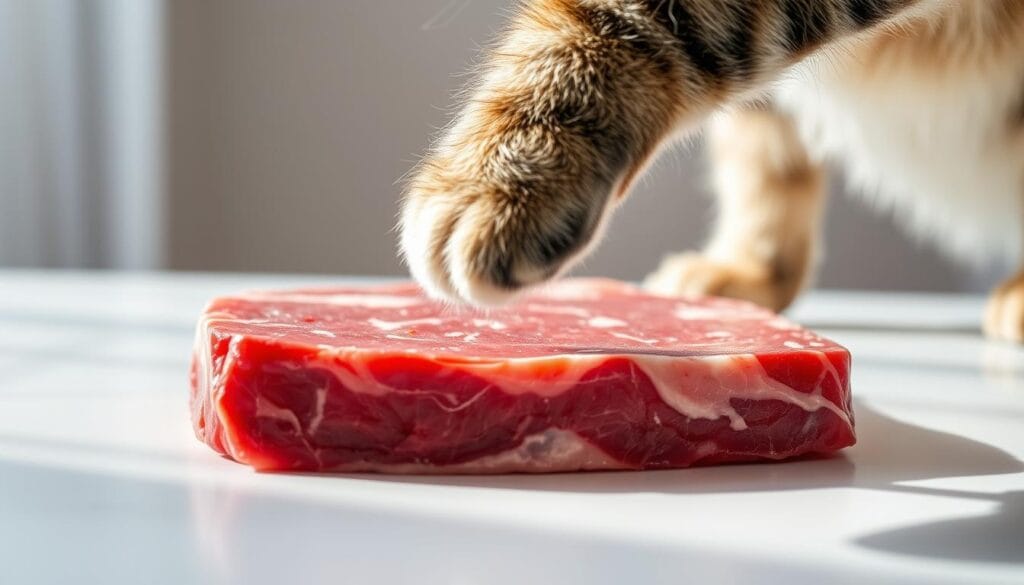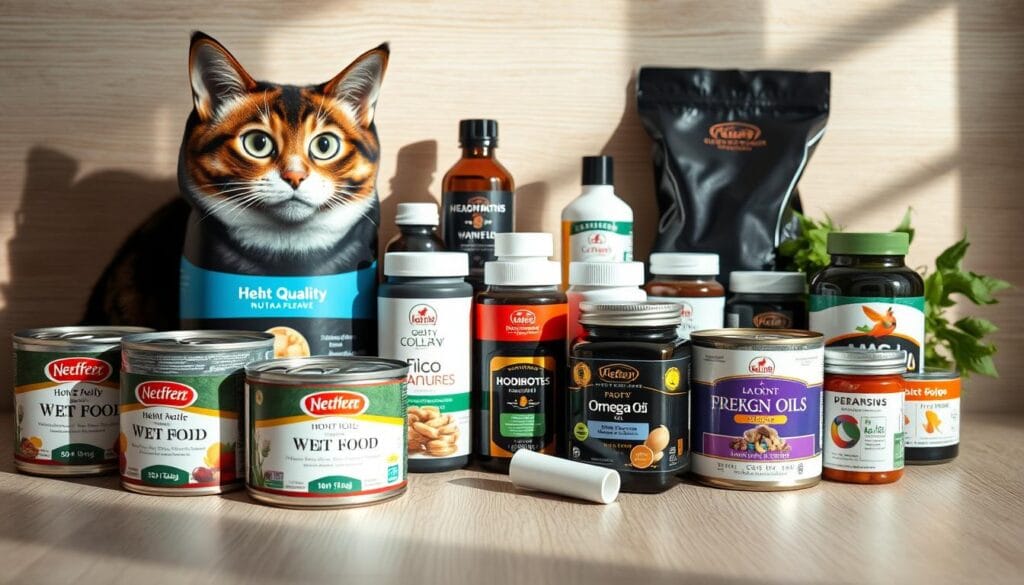Can cats eat raw beef? A comprehensive guide.
Table of Contents
Can cats eat raw beef ?
Many pet owners grapple with balancing their cat’s natural instincts and modern safety standards. You might wonder whether those eager eyes staring at your dinner plate could benefit from uncooked meals. While the idea of mimicking a wild diet feels intuitive, the reality requires careful consideration.
Feeding uncooked animal products sparks heated debates among veterinarians and enthusiasts alike. Potential benefits like shinier coats or improved digestion often clash with risks of harmful bacteria. Every nutritional choice carries weight when it comes to your furry friend’s well-being.
This guide breaks down essential factors for making informed decisions. You’ll explore how a cat’s biology as an obligate carnivore influences dietary needs. We’ll also address contamination threats like Salmonella and E. coli that impact entire households.
Consulting a trusted veterinarian remains non-negotiable before altering meals. They provide tailored advice based on your pet’s health history and lifestyle. Together, you can weigh the pros and cons while prioritizing safety.
Key Takeaways:
- Raw diets involve bacterial risks affecting pets and humans
- Professional guidance ensures balanced nutrition
- Individual health needs dictate suitable food choices
Introduction to Raw Cat Diets
The shift toward natural pet nutrition has spotlighted uncooked meal plans. These regimens aim to replicate ancestral eating patterns while addressing modern health concerns. But what exactly goes into these unconventional feeding strategies?
What Does a Raw Diet Entail?
A balanced raw food plan combines muscle tissue, organs, and edible bones. Commercial options often include supplements to meet nutritional standards. Two main categories exist:
- Complete formulas designed for standalone feeding
- Complementary mixes requiring additional food sources
Homemade versions demand veterinary supervision to prevent nutrient gaps. Without proper ratios of calcium, taurine, and vitamins, your feline companion could develop severe deficiencies.
Benefits and Potential Hazards Overview
Advocates report shinier coats and healthier weight profiles in pets on raw diets. Some notice smaller, less odorous waste due to efficient digestion. However, bacterial risks like Salmonella lurk in untreated proteins.
Handling protocols become critical – surfaces and utensils require thorough sanitization. While pre-made raw food undergoes safety testing, DIY preparations increase contamination chances. Always consult your vet before transitioning meals.
Can Cats Eat Raw Beef?
Offering uncooked animal protein to your feline companion requires balancing nutritional benefits with food safety priorities. While not inherently toxic, fresh unprocessed beef may serve as an occasional treat under strict conditions. Always prioritize your pet’s well-being by understanding contamination risks and dietary limitations.

Pathogens like Salmonella and Listeria frequently inhabit untreated meats. These bacteria trigger vomiting, diarrhea, and lethargy in pets. Human family members face similar contamination risks through improper handling.
Ground varieties often contain excessive fat levels unsuitable for carnivores. Compare nutritional profiles:
| Protein Source | Fat Percentage | Safe Serving Size |
|---|---|---|
| Lean Beef Cubes | 10-15% | 1-2 tbsp weekly |
| Ground Beef | 25-30% | Not recommended |
| Commercial Raw Food | 8-12% | Follow package guidelines |
Selecting high-quality cuts minimizes hazards. Choose fresh, hormone-free options from reputable suppliers. Freeze portions for 72 hours before serving to reduce microbial loads.
Never substitute complete meals with plain muscle tissue. Essential nutrients like taurine and calcium require supplementation through balanced diets. Consult your veterinarian to create safe feeding protocols tailored to your pet’s needs.
Assessing the Pros and Cons of Raw Feeding
Deciding what to feed your pet involves careful evaluation of nutritional gains versus potential dangers. Advocates highlight transformative effects on wellness, while critics emphasize biological threats demanding attention. Let’s examine both perspectives objectively.
Exploring the Benefits for Feline Health
Digestive health improvements rank among the most cited advantages. Many pets experience reduced stool odor and volume due to efficient nutrient absorption. This often indicates better utilization of proteins and fats.
High moisture content supports hydration, critical for urinary tract function. Pets consuming moisture-rich meals may lower risks of kidney issues. Weight management also becomes simpler with protein-focused nutrition promoting lean muscle mass.
Anti-inflammatory properties in unprocessed meals might ease allergy symptoms. Skin irritations and gastrointestinal distress sometimes diminish when switching to whole-food regimens. Always monitor changes with your veterinarian.
Understanding the Risks and Safety Concerns
Pathogens like Salmonella multiply rapidly in untreated proteins. Symptoms including vomiting and fever can emerge within hours of consumption. Immunocompromised pets face heightened dangers from these infections.
Listeria contamination poses severe neurological threats, including muscle stiffness. E. coli strains may trigger urinary complications requiring urgent care. Proper freezing and handling reduce but don’t eliminate these hazards.
Households with children or elderly members need strict sanitation protocols. Surfaces and utensils require thorough disinfection after meal preparation. Consult professionals to create safe handling routines tailored to your lifestyle.
Understanding Nutritional Needs of Your Cat
Your feline companion’s biology demands precise nutritional building blocks found only in animal tissues. Unlike omnivores, their bodies can’t produce essential compounds internally. This makes every meal critical for maintaining vital organ functions and long-term health.

Critical Nutrients in a Balanced Diet
Muscle tissue forms the foundation of proper nutrition, delivering protein for energy and tissue repair. However, complete meals require organ meats like liver for vitamin A and kidneys for B vitamins. Bone matter or supplements provide calcium for skeletal strength.
Taurine stands out as the most crucial amino acid. Deficiencies can lead to heart failure and vision loss within months. Commercial food formulas include this nutrient, but homemade diets often lack adequate amounts without careful planning.
Growing kittens need particularly high protein levels – at least 50% of their diet. Fat content supports brain development, while controlled calcium prevents bone abnormalities. Prebiotic fibers from sources like pumpkin aid digestion without adding unnecessary carbs.
Creating balanced meals requires understanding complex nutrient ratios. Partner with a veterinary nutritionist to address your pet’s specific needs. They’ll help prevent deficiencies that might not show symptoms until irreversible damage occurs.
Preparation and Handling of Raw Meat
Proper techniques transform fresh ingredients into safe meals for your pet. Start by selecting high-quality meat from trusted suppliers. Look for balanced fat content – neither too lean nor excessively fatty – to support energy needs without digestive strain.
Safe Storage Practices
Freeze portions immediately in airtight containers to preserve freshness. Divide large batches into single-serving sizes for easy thawing. Rotate protein sources like chicken, rabbit, or turkey weekly to provide nutritional variety over time.
Thaw frozen meat in the refrigerator for 12-24 hours before serving. Never refreeze thawed portions, as this increases bacterial growth risks. Discard uneaten food after 30 minutes to prevent spoilage.
Preventing Bacterial Contamination
Designate specific utensils and cutting boards for pet meal prep. Wash hands thoroughly with antibacterial soap before and after handling ingredients. Sanitize surfaces with vinegar or pet-safe disinfectants post-preparation.
Serve meat in chunky pieces rather than ground form. This texture mimics natural prey while reducing surface area for bacteria spread. Room-temperature servings improve palatability and digestion compared to cold portions.
Consider these storage timelines for optimal safety:
- Freezer: 3-4 months at 0°F
- Refrigerator: 1-2 days after thawing
- Countertop: Never exceed 20 minutes
Balancing Your Cat’s Diet: Raw vs. Cooked Options
Choosing the right nutrition plan requires weighing modern convenience against ancestral habits. While raw diets spark curiosity, research shows no proven health advantages over properly prepared cooked meals. Bacterial risks often outweigh potential benefits, especially in multi-pet households.
High-quality wet food offers a safer middle ground. These formulas provide 78% moisture – critical for urinary health – alongside balanced proteins and fats. Unlike raw options, commercial wet diets undergo rigorous safety testing while meeting feline nutritional needs.
Portion-controlled meals help maintain ideal weight and energy levels. Rotate protein sources like chicken or turkey to mimic natural hunting variety. Always consult your veterinarian when adjusting your pet’s diet, as individual health conditions dictate optimal choices.
Your cat’s well-being hinges on informed decisions backed by science. Prioritize safety and convenience without compromising on essential nutrients. With professional guidance, you can craft a feeding strategy that keeps your companion thriving for years.
- read aslo :
- Dry Cat Food Recipes
- Wet cat Food Recipes
- Special Cat Food Recipes
- Chicken Cat Food Recipes
- Homemade Cat Food Recipes
- Can cats eat chicken and what are the health benefits?
- Can cats have chicken as a protein source? Comprehensive guide
- Can Cats Eat Raw Chicken? Safety Guide for Cat Owners
- Dry Cat Food Brands Loved by Cats and Trusted by Vets
- Best Cat Food for Sensitive Stomach:Top 5 Vet-Approved Picks
- Special Kitty Kitten Food – Learn the Pros and Cons
- prescription cat food-Top 10 Prescription Cat Foods
- Wet Cat Food for Kittens: Top Nutritious Choices 2025
- How Long Can Wet Cat Food Sit Out? Critical Facts
- American Veterinary Medical Association (AVMA)

